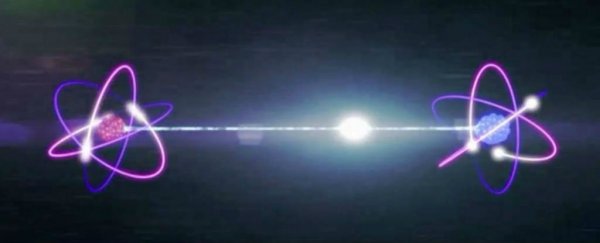Scientists investigating how light particles (or photons) experience entanglement on the quantum scale have discovered something entirely unexpected, and it challenges long-held assumptions about the initial moments of what Einstein referred to as "spooky action at a distance".
When the team created entangled pairs of photons, these particles didn't originate in the same place and break away as predicted - they emerged from entirely different points in space, which means quantum theory might have to account for a whole lot more randomness than we thought.
"Until now, it has been assumed that such paired photons come from the same location," says one of the researchers, David Andrews from the University of East Anglia in the UK.
"Now, the identification of a new delocalised mechanism shows that each photon pair can be emitted from spatially separated points, introducing a new positional uncertainty of a fundamental quantum origin."
The team figured this out by performing a very simple entanglement experiment called spontaneous parametric down-conversion (SPDC), which involves firing photon beams through a crystal such as barium borate, to generate entangled pairs of light particles.
As Spooky Action at a Distance author, George Musser, explains:
"If you set up the crystal properly, the amplification is so powerful that it turns the noise into a proper light beam. A single incoming beam (typically blue or ultraviolet) can thus conjure up two beams (typically red). This process occurs particle by particle: each blue photon splits into two red ones."
Here's a demonstration of the process:
When the single photons split into two - and this usually only occurs in around one in a billion photons - the pair experience quantum entanglement, a phenomenon where two particles interact in such a way that they become deeply linked, and essentially 'share' an existence.
This means that what happens to one particle will directly and instantly affect what happens to the other - even if its partner is many light-years away.
It was assumed that when the single photons are split into entangled pairs, they emerge from the same point in the crystal, and share properties such as energy, momentum, and polarisation at speeds of at least 10,000 times the speed of light.
But what Andrews and his team found was that these split pairs could actually appear in entirely different parts of the crystal.
"The paired photons can emerge with separations in their origin of hundredths of a micron - despite being entangled," he told Michael Franco at New Atlas.
"[I]t is as if they were not even born close together in terms of atomic dimensions."
The question now is, how do we know where those different positions will be?
The researchers suspect that the positions are influenced by individual variations in the photons, and the next step will be to independently confirm this behaviour, and establish a method to predict where the photons could crop up.
There are a lot of questions now up in the air, but one thing's for sure - photons have a whole lot more mystery to them than we gave them credit for.
As Andrews says in a press statement: "Everything has a certain quantum 'fuzziness' to it, and photons are not the hard little bullets of light that are popularly imagined."
The research has been published in Physical Review Letters.
